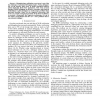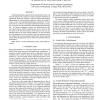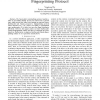146 search results - page 9 / 30 » Sequential Traitor Tracing |
CCS
2006
ACM
14 years 23 days ago
2006
ACM
We introduce a simple primitive called Augmented Broadcast Encryption (ABE) that is sufficient for constructing broadcast encryption, traitor-tracing, and trace-and-revoke systems...
ASPDAC
2010
ACM
13 years 7 months ago
2010
ACM
Managing long verification error traces is one of the key challenges of automated debugging engines. Today, debuggers rely on the iterative logic array to model sequential behavior...
ICIP
2007
IEEE
14 years 10 months ago
2007
IEEE
Multi-user collusion is an cost-effective attack against digital fingerprinting, in which a group of attackers collectively undermine the traitor tracing capability of digital fin...
ICIP
2006
IEEE
14 years 10 months ago
2006
IEEE
Digital fingerprinting uniquely labels each distributed copy with user's ID and provides a proactive means to track the distribution of multimedia. Multi-user collusion is a ...
ICC
2007
IEEE
14 years 3 months ago
2007
IEEE
— The buyer-seller watermarking protocol enables a seller to successfully identify at least one traitor from a pirated copy, while prevent the seller from framing an innocent buy...



